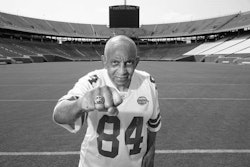Restoring the Talent PipelineEven though Black college baseball is going through its own facelift of sorts, the game’s observers believe that a concerted effort at the grass-roots level can spur a larger number of Black youngsters to play the sport at an early age, which in turn would help restore the talent pipeline to colleges and the majors.
Reviving Baseball in Inner Cities (RBI) is perhaps the best known of these grass-roots efforts. Founded in 1989 by former pro player and scout John Young, RBI’s chief focus is to promote the game to youngsters from disadvantaged backgrounds. The dwindling number of Black youngsters playing baseball in Young’s home turf, the South Central section of Los Angeles, sparked his desire to develop a program that would expose Black youngsters to the game, while providing them with avenues to acquire the necessary academic skills to attend college.
In its 13 years of operation, RBI, which is sponsored by Major League Baseball, has continued to expand and serves over 110,000 boys and girls in 160 cities worldwide. A key element in the RBI program is the Academy of Excellence, which provides participants with individual tutoring, college and SAT preparation, and classes in time management and goal setting. On the athletic side, participants play in competitive leagues with the opportunity to play on all-star teams in prestigious tournaments that pro scouts attend regularly.
“RBI has created more of a consciousness of the shortage of Blacks playing baseball,” says Young, a former director of scouting for the Detroit Tigers. “Statistically, though, things haven’t gone as well as we had hoped,” Young says. “The trend when we first started in ’89 isn’t that much different from today. Most players in college baseball are White or foreign born.”
In an effort to counter that trend, RBI is moving toward focusing on even younger kids.
“In the past, we’ve put most of our efforts in reaching kids 13 and older, particularly the high-school-age youngsters,” Young says. “Now we need to put more of the program’s resources on the younger kids, those who are 12 and younger. We have to make sure the support is there by providing the necessary equipment, playing fields and supplying knowledgeable coaches.
“Baseball is a sport where you get better by repetition. If you can get youngsters started at an earlier age, and they know there’s a program in place that will provide good competition and give them a chance to get a college education, that’s going to help a lot.” Young says. “We have to start identifying these youngsters with talent before they reach age 13, just like those select basketball teams who travel and play all over the country.” — By Craig T. Greenlee
© Copyright 2005 by DiverseEducation.com















